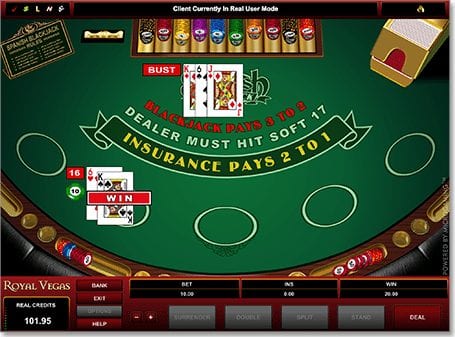 Spanish 21 is very similar to standard blackjack, but puts a twist on the rules. The rule variations means the game has a higher house edge traditional blackjack, but it still remains extremely popular at both land-based and online casinos.
Spanish 21 is very similar to standard blackjack, but puts a twist on the rules. The rule variations means the game has a higher house edge traditional blackjack, but it still remains extremely popular at both land-based and online casinos.
In Australia, Spanish 21 is called Pontoon. This isn’t to be confused with the pontoon titles available online as these have a completely different set of rules. If you are sitting at a virtual pontoon table and notice both of the dealer’s cards are face down, you are not playing Spanish 21. Online it is still known as Spanish 21 so be sure not to get the titles mixed up, and perhaps wait until you are completely awake from your Siesta so you can devote 100% of your concentration.
Where did Spanish 21 come from?
Spanish 21 was named as such because it is played with a Spanish deck of cards, which is only 48 cards, with the four 10s removed from the original 52 deck. The face cards which value 10 remain, however the removal of the four 10s means it is harder to get 21.
In North America it is known in land-based casinos as Pontoon, similar to Australia as mentioned above, however players will find the game under Spanish 21 online. There have been suggestions games which seem to have similar rules played in Spain in the 1500’s and hence had fuel to the fire that the game was indeed born there.
The only confirmed history of the game is it was introduced to Las Vegas casino’s in the 1990s by an employee who wanted to encourage player participation and slowly popped up in more and more land-based casinos around the world. It has only recently become available online and there aren’t an abundance of titles available, nor are they available at every Internet casino.
How to play Spanish blackjack
The game is based on the classic blackjack game with the same betting idea, but with different rules. Spanish blackjack can be played using four, six, or eight decks each with their 10s removed. With the 10s removed the odds are in the dealer’s favour, however this is counteracted by the addition of bonuses that help the players out and create wagers which are quite popular. Online the rules are usually fixed, while at land-based casinos they can vary. Additionally, if you are playing at land-based venues it is important to remember the rules may vary in different countries.
Rules of Spanish 21
If you know how to play the standard game of blackjack, whether it be online or offline, you have the basic foundation of Spanish 21. It is important to know if you play the same rules, you will lose. To win, all you need to know is what is different and which bets are best.
Common rules in Spanish blackjack
- 1. A player who gets 21 always wins -they beat the dealer even if the dealer gets blackjack too.
- 2. Players can double after they split.
- 3. Doubling down is accepted on two cards or more, regardless if they player has split.
- 4. The dealer gets a hole card.
- 5. Late surrender is accepted, which decreases the house edge. However this rule isn’t allowed if the dealer has blackjack.
- 6. Players can re-split aces.
- 7. When splitting aces players can hit and double down.
- 8. Players may double down rescue, which is where they surrender after doubling and can rescue the latter portion of their bet and lose the initial bet.
- 9.Even though the four 10s are missing, insurance still pays two to one, however it has an incredibly high house advantage for this game at 24.7% -which is one of the worst bets players can make.
- 10. The dealer peeks to check for blackjack if they reveal an Ace of a King, Queen, or Jack. The only way players can win if the dealer has blackjack, if they have blackjack too.
Variable Spanish 21 rules
- 1. A soft 17 may see a dealer hit or stand.
- 2. The amount of Spanish decks may change.
- 3. Redoubling may be allowed.
- 4. Some casinos allow an ace and a face card after splitting to be blackjack.
- 5. There is also a Match the Dealer option, which is known as a side bet. It sees a player’s cards compared to the dealers face up card and the player will win if their cards match the rank of the dealer’s cards. For example, a five matches a five, and a queen matches a queen. There are a number of combinations with different payouts including, if both cards match with the suits and all the payout is 24:1; one suited match and one non-suited match pays 15:1; while just one suited match sees a payout of 12:1; two non-suited sees a payout of six to one; while just one non-suited pays at three to one.
Bonus rules in Spanish 21
The reason Spanish 21 is so popular is the bonuses the game offers. If players land a certain hand, they are eligible for the generous bonus payouts.
- 1. Players who get 21 with five cards see a payout of three to one, where as 21 with six cards pays two to one, and seven or more cards with a total of 21 pays three to one.
- 2. Landing mixed suits of 7,7,7 or even 6,7,8, offers a payout of three to two, and two to one for all the same suit. If it is all spades there is a payout of three to one. Some casinos may accept it but normally the bonus payouts aren’t offered if a player has doubled or split.
- 3. If the dealer has a seven facing upwards and a player has three sevens of the same suit, wagers from $5 to $24 are paid $1000, while bets of $25 and over pay $5000. Every other player receives a sneaky $50, which is known as the ‘envy bonus’. The bonus is not available to players who double or split.
Basic Spanish blackjack strategy
Similar to blackjack, players will need a basic strategy to effectively play Spanish 21 if they aim to have a chance of winning against the house. You can find basic strategy charts online but we have put together the best tips for Spanish 21 strategy.
When to stand:If you draw a hard 18 or higher, or even a soft 19 or higher, we recommended to always stand.
When to hit: We always hit on a soft 13, 14 or 15 as well as with a hard eight or less, and a hard 12.
When to double down: We recommend doubling down with a hard 10 if the dealer has anywhere from a two to a seven; a soft 16 or hard nine if the dealer has a six; if the dealer has a two to an eight, and you have an 11; if the dealer reveals a four and you have a soft 17; or if you have a soft 18 with the dealer showing a four to a six.
When to split: If you have a pair of aces we recommend to always split these, while you should avoid splitting a pair of fours to sixes. Another pair to always split on is eights, though if the dealer has an ace avoid this. If the dealer shows anything from a three to a seven and you have a pair of twos, threes, or sevens, we would split. You should also split nines if the dealer reveals an amount from three to nine, except for the amount of seven.



